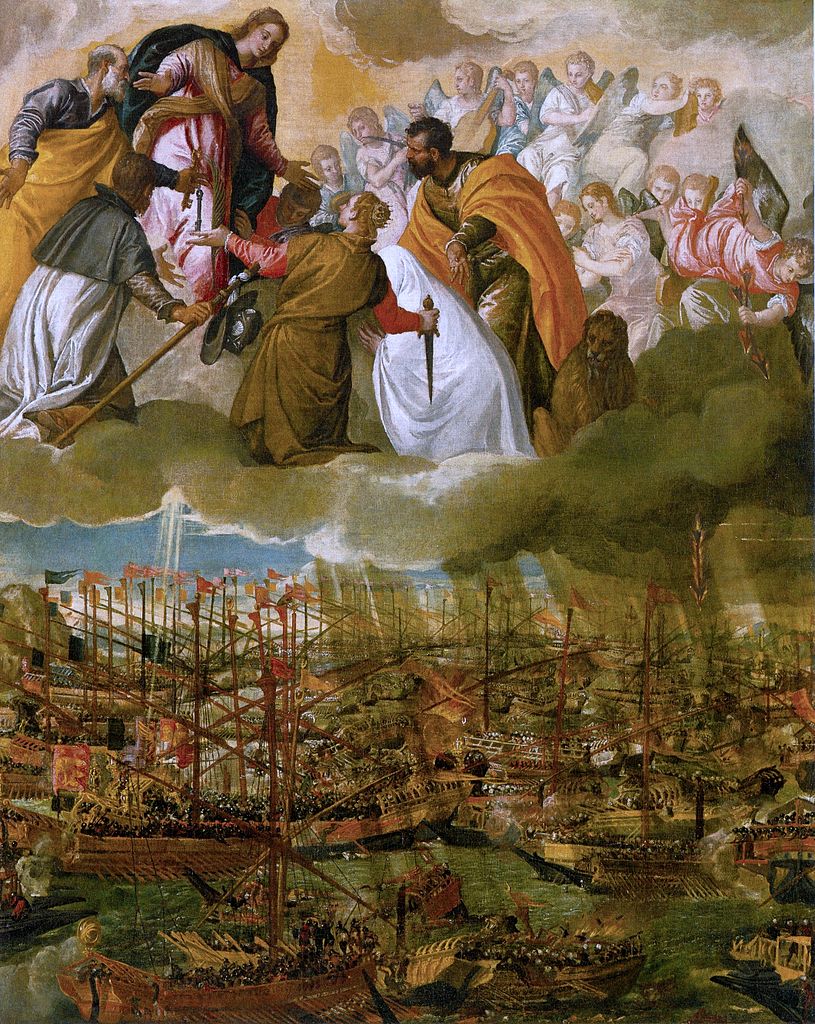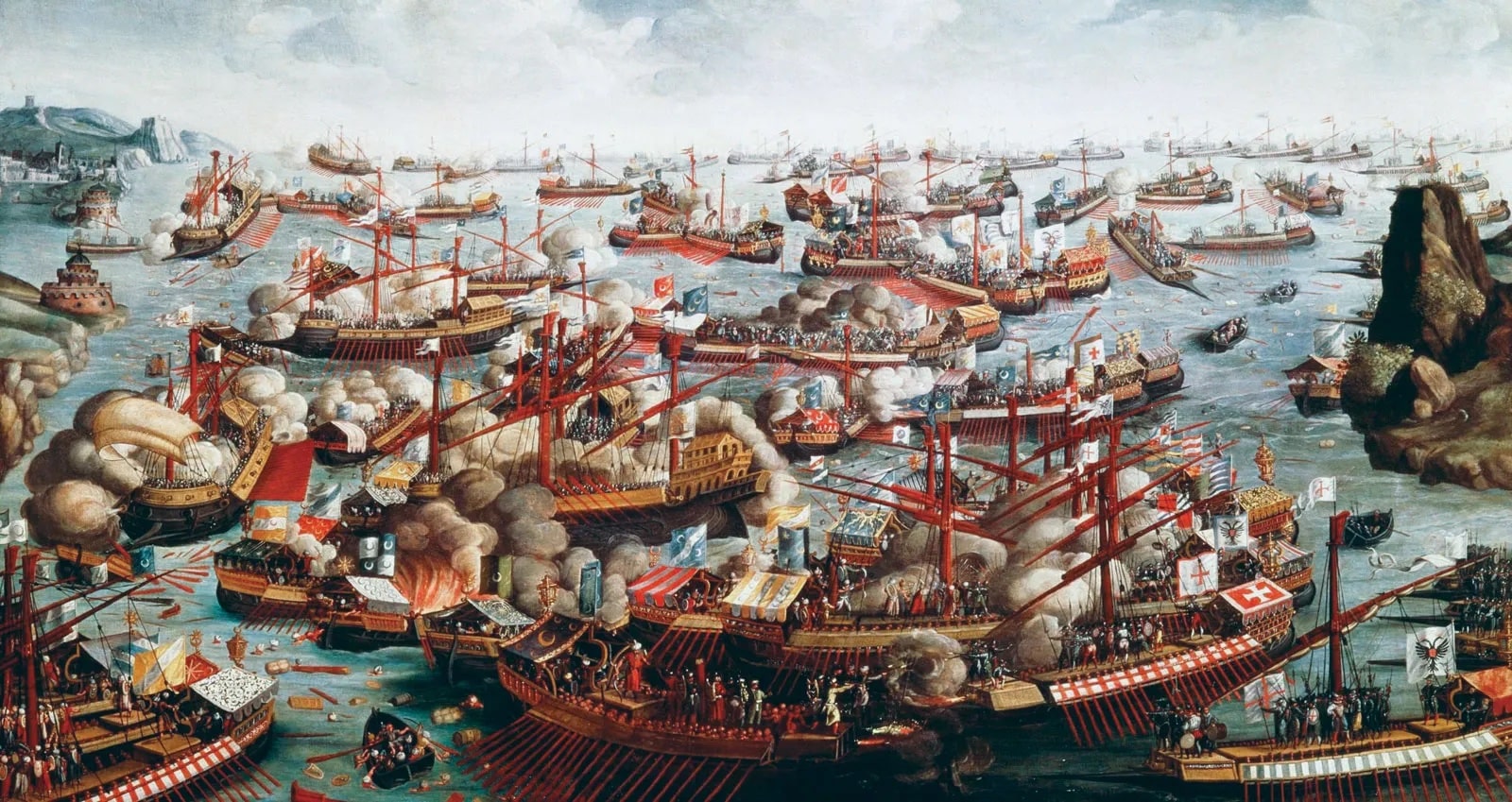Relations between the West and the Ottoman Empire were poisoned by political, cultural, and religious conflicts around the end of the 16th century. Multiple confrontations between the two superpowers began as early as 1463, when Turkish expansionism in the Mediterranean triggered tensions. Sultan Selim II of the Ottoman Empire set out to conquer Venice’s dominion of Cyprus in 1570. The raid initiated the fourth conflict between Venice and the Ottoman Empire.
Pope Pius V established the Holy League on May 25, 1571, in an effort to halt the advancing Turks. At the naval battle of Lepanto on October 7, 1571, the fate of Cyprus was decided.
There, off the Greek coast to the west, Don Juan of Austria led a Christian navy into battle against Selim II’s armada. The Turkish fleet was utterly destroyed by the combined armies of Spain and Venice in a matter of hours. About 7,500 Christians were killed, while at least twice as many Turks perished. Because of the Holy League’s victory at Lepanto, Ottoman expansionism in the Mediterranean was finally halted.
What Were the Causes of the Battle of Lepanto?
The city of Lepanto, on the west coast of Greece, plays a pivotal role in the events leading up to the decisive Battle of Lepanto. Since Constantinople’s fall in 1453, Europe and the Ottoman Empire have been at loggerheads about who should control the Mediterranean. The Republic of Venice and its allies fought several brutal battles against the Ottoman Empire. Sultan Selim II, son of Suleiman the Magnificent, set his sights on Cyprus in 1570 because he aspired to be a conqueror. In a few months, he conquered the island that served as the hub of the Venetian maritime empire and an economic nexus between Europe and the Middle East. Pope Pius V called on the European countries to join him in a crusade to retake the city and put a stop to Ottoman expansionism. To set aside their differences, the Christian forces formed an alliance known as the Holy League.
Who Fought in the Battle of Lepanto?
The Christian Holy League fought against the Turkish fleet of Sultan Selim II in the Battle of Lepanto. The Ottoman Empire, which had been established in the late 13th century with the intention of expanding by conquest, remained one of the world’s leading powers as late as 1571. From the Black Sea to the Mediterranean, it contended with Western interests throughout its expansive frontiers. Nearly 250 galleys and 45 galleots, under the leadership of Admiral Ali Pasha, made up the Turkish fleet during the Battle of Lepanto. There were also about 700 artillery and 13,000 sailors in addition to the 34,000 soldiers. Ali Pasha, Mohammed Sirocco, and Occhiali were the Turkish generals in charge of the army.
In May 1571, the Habsburgs of Spain, the republics of Genoa and Venice, the Papal States, the Duchy of Savoy, and the Hospitallers established an alliance known as the Holy League to fight the Turks. Prince Juan of Austria commanded a force of over 200 ships, 1,800 guns, and around 30,000 mainly Spanish and Venetian troops. The latter was a half-brother of King Philip II of Spain as the illegitimate son of Emperor Charles V. Miguel de Cervantes, the author of “Don Quixote,” also fought on the side of the Christians. The writer loses the use of his left hand in this conflict and becomes known as the “Penguin of Lepanto.” Juan of Austria (Spain), Sebastiano Venier (Venice), Marcantonio Colonna (Vatican City), etc. lead the Holy League.
Who Won the Battle of Lepanto?
The Christian fleet reached the Gulf of Lepanto on October 7, 1571, after having sent spies to find the Turkish navy. Due to the narrow gulf’s confinement and lack of escape routes, the Ottomans were at a disadvantage when this conflict began. The Christian guns scattered the Turkish fleet, which led to a storm on Ali Pasha’s ship.
The admiral’s head was severed and mounted on the top of a mast. The already battered Ottoman sailors’ morale completely plummeted, and only a small number of galleys made it to safety. After just a few hours of fighting, the Holy League achieved a stunning victory over the formerly unbeatable Turkish navy. In addition to the 137 seized ships and 50 sunk, the Christian side lost 7,500 men and suffered 20,000 injuries, while the Turkish side lost the same number of men and had 20,000 injuries, and both sides lost a total of 50 ships.
What Was the Results of the Battle of Lepanto?
Despite a resounding impact in the West, the success of the Holy League at Lepanto did not change the course of the conflict. The Ottoman Empire quickly reconstituted its naval force and kept control of all its conquests in the Mediterranean. However, the loss of many experienced sailors was a severe blow to the Sultan. He had to leave the western Mediterranean to Spain and its Italian allies. The Holy League, despite the victory, did not manage to recover the lost territories. With the death of Pope Pius V on May 1, 1572, the European coalition began to break up.
On March 7, 1573, a peace treaty was finally signed between the Ottoman Empire and the Republic of Venice. The latter, ruined by the war, ceded Cyprus to the Turks in exchange for the resumption of commercial exchanges. France, which had not taken part in the conflict, remained an ally of the Ottomans due to religious wars paralyzing it. If it made it possible to definitively stop the Turkish expansion in the Mediterranean, the principal consequence of the battle of Lepanto was especially symbolic. The victory of Christianity over Islam thus generated the awakening of a European conscience linked to a common faith.
How Was the Battle of Lepanto Immortalized?

Many Western painters of the period depicted the battle of Lepanto in their works. Specifically, Veronese, Titian, and Tintoretto are the three best Venetian painters of the late Renaissance. In its top portion, Paola Veronese’s “Allegory of the Battle of Lepanto” has a presentation of Venice to Mary. At the same time, Tintoretto, whose real name was Jacopo Robusti, painted “The Battle of Lepanto.” Tiziano Vecellio, better known as Titian, one of the best portraitists of the period, also finished his “Allegory of the Battle of Lepanto” in 1575. King Philip II of Spain sacrificed his baby son Ferdinand for the sake of triumph and God. There is a widespread Christian belief that praying the Rosary before going to battle with the Turks helped secure a victory in the Battle of Lepanto.
The next year, on October 7th, Pius V established “The Feast of Our Lady of Victory” to celebrate the event. When his successor, Pope Gregory XIII, took office in 1573, he moved the celebration of the Holy Rosary to the first Sunday of each month and changed its name to the Feast of the Holy Rosary.
Bibliography:
- Bicheno, Hugh. Crescent and Cross: The Battle of Lepanto 1571, pbk., Phoenix, London, 2004, ISBN 1-84212-753-5
- Capponi, Niccolò (2006). Victory of the West:The Great Christian-Muslim Clash at the Battle of Lepanto. New York: Da Capo Press. ISBN 0-306-81544-3.
- anson, Victor Davis (2010). The Father of Us All: War and History, Ancient and Modern. New York: Bloomsbury Press. ISBN 978-1-60819-410-0.
- Guilmartin, John F. (2003). Galleons and Galleys: Gunpowder and the Changing Face of Warfare at Sea, 1300–1650. Cassell. pp. 149–50.
- Hopkins, T.C.F. (2006). Confrontation at Lepanto: Christendom vs. Islam. New York: Forge Books. ISBN 978-0-76530-539-8.


